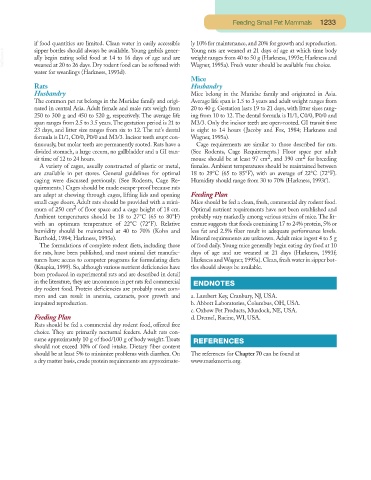Page 1183 - Small Animal Clinical Nutrition 5th Edition
P. 1183
Feeding Small Pet Mammals 1233
if food quantities are limited. Clean water in easily accessible ly 10% for maintenance, and 20% for growth and reproduction.
VetBooks.ir sipper bottles should always be available. Young gerbils gener- Young rats are weaned at 21 days of age at which time body
weight ranges from 40 to 50 g (Harkness, 1993e; Harkness and
ally begin eating solid food at 14 to 16 days of age and are
weaned at 20 to 26 days. Dry rodent food can be softened with
Wagner, 1995a). Fresh water should be available free choice.
water for weanlings (Harkness, 1993d).
Mice
Rats Husbandry
Husbandry Mice belong in the Muridae family and originated in Asia.
The common pet rat belongs in the Muridae family and origi- Average life span is 1.5 to 3 years and adult weight ranges from
nated in central Asia. Adult female and male rats weigh from 20 to 40 g. Gestation lasts 19 to 21 days, with litter sizes rang-
250 to 300 g and 450 to 520 g, respectively. The average life ing from 10 to 12. The dental formula is I1/1, C0/0, P0/0 and
span ranges from 2.5 to 3.5 years.The gestation period is 21 to M3/3. Only the incisor teeth are open-rooted. GI transit time
23 days, and litter size ranges from six to 12. The rat’s dental is eight to 14 hours (Jacoby and Fox, 1984; Harkness and
formula is I1/1, C0/0, P0/0 and M3/3. Incisor teeth erupt con- Wagner, 1995a).
tinuously, but molar teeth are permanently rooted. Rats have a Cage requirements are similar to those described for rats.
divided stomach, a large cecum, no gallbladder and a GI tran- (See Rodents, Cage Requirements.) Floor space per adult
2
2
sit time of 12 to 24 hours. mouse should be at least 97 cm , and 390 cm for breeding
A variety of cages, usually constructed of plastic or metal, females. Ambient temperatures should be maintained between
are available in pet stores. General guidelines for optimal 18 to 29°C (65 to 85°F), with an average of 22°C (72°F).
caging were discussed previously. (See Rodents, Cage Re- Humidity should range from 30 to 70% (Harkness, 1993f).
quirements.) Cages should be made escape-proof because rats
are adept at chewing through cages, lifting lids and opening Feeding Plan
small cage doors. Adult rats should be provided with a mini- Mice should be fed a clean, fresh, commercial dry rodent food.
2
mum of 250 cm of floor space and a cage height of 18 cm. Optimal nutrient requirements have not been established and
Ambient temperatures should be 18 to 27°C (65 to 80°F) probably vary markedly among various strains of mice.The lit-
with an optimum temperature of 22°C (72°F). Relative erature suggests that foods containing 17 to 24% protein, 5% or
humidity should be maintained at 40 to 70% (Kohn and less fat and 2.5% fiber result in adequate performance levels.
Barthold, 1984; Harkness, 1993e). Mineral requirements are unknown. Adult mice ingest 4 to 5 g
The formulations of complete rodent diets, including those of food daily. Young mice generally begin eating dry food at 10
for rats, have been published, and most animal diet manufac- days of age and are weaned at 21 days (Harkness, 1993f;
turers have access to computer programs for formulating diets Harkness and Wagner,1995a).Clean,fresh water in sipper bot-
(Knapka, 1999). So, although various nutrient deficiencies have tles should always be available.
been produced in experimental rats and are described in detail
in the literature, they are uncommon in pet rats fed commercial ENDNOTES
dry rodent food. Protein deficiencies are probably most com-
mon and can result in anemia, cataracts, poor growth and a. Lambert Key, Cranbury, NJ, USA.
impaired reproduction. b. Abbott Laboratories, Columbus, OH, USA.
c. Oxbow Pet Products, Murdock, NE, USA.
Feeding Plan d. Dremel, Racine, WI, USA.
Rats should be fed a commercial dry rodent food, offered free
choice. They are primarily nocturnal feeders. Adult rats con-
sume approximately 10 g of food/100 g of body weight. Treats REFERENCES
should not exceed 10% of food intake. Dietary fiber content
should be at least 5% to minimize problems with diarrhea. On The references for Chapter 70 can be found at
a dry matter basis, crude protein requirements are approximate- www.markmorris.org.

